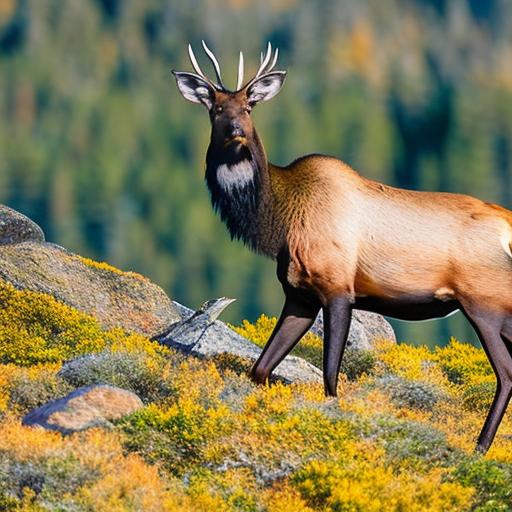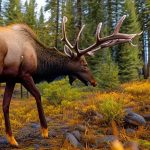Your cart is currently empty!

Chasing the Majestic Roosevelt Elk: A Hunter’s Guide to the Ultimate Adventure

Roosevelt Elk hunting is a thrilling and challenging pursuit that has captivated hunters for generations. The allure of the hunt lies in the majestic beauty of these magnificent creatures and the thrill of matching wits with such a formidable opponent. Roosevelt Elk, also known as Olympic Elk, are the largest species of elk in North America and can be found in the Pacific Northwest region of the United States.
Key Takeaways
- Roosevelt Elk hunting requires understanding their habitat and behavior
- Essential gear and equipment are necessary for a successful hunt
- Timing and location are crucial for planning a Roosevelt Elk hunting trip
- Spotting and tracking techniques are important for finding Roosevelt Elk
- Approaching and stalking tips can increase the chances of a successful hunt
Understanding the Habitat and Behavior of Roosevelt Elk
To be successful in hunting Roosevelt Elk, it is crucial to have a deep understanding of their natural habitat and behavior. These elk are primarily found in dense forests, often near water sources such as rivers or lakes. They prefer areas with ample vegetation for grazing and cover for protection.
Roosevelt Elk are known for their elusive nature and cautious behavior. They are highly sensitive to human presence and can quickly detect any signs of danger. They have excellent hearing and sense of smell, making it challenging for hunters to get close to them without being detected.
Essential Gear and Equipment for Roosevelt Elk Hunting
When embarking on a Roosevelt Elk hunting trip, it is essential to have the right gear and equipment to ensure a successful and safe hunt. Some of the necessary gear includes a high-quality rifle or bow, appropriate ammunition or arrows, binoculars, a range finder, a backpack, a knife, and appropriate clothing for the weather conditions.
Choosing the right gear can be overwhelming, especially for beginners. It is crucial to invest in high-quality equipment that suits your needs and budget. Researching different brands and reading reviews can help you make informed decisions. Additionally, consulting with experienced hunters or visiting a hunting store can provide valuable insights into selecting the right gear.
Planning Your Roosevelt Elk Hunting Trip: Timing and Location
| Timing | Location | Weather | Population | Success Rate |
|---|---|---|---|---|
| September – November | Olympic National Park, Washington | Wet and cool | ~4,000 | ~20% |
| December – January | California, Oregon, and Washington | Cold and snowy | ~10,000 | ~30% |
| February – March | Olympic National Park, Washington | Cold and wet | ~4,000 | ~10% |
Timing and location are crucial factors when planning a Roosevelt Elk hunting trip. The best time to hunt these majestic creatures is during the rutting season, which typically occurs in the fall. During this time, the bulls are more active and vocal, making it easier to locate them.
Choosing the right location is equally important. Roosevelt Elk can be found in several states, including Oregon, Washington, and California. Researching different hunting areas and consulting with local wildlife agencies can help you determine the best location for your hunt. It is also essential to familiarize yourself with the hunting regulations and obtain any necessary permits or licenses.
Techniques for Spotting and Tracking Roosevelt Elk
Spotting and tracking Roosevelt Elk in the wild requires patience, skill, and knowledge of their behavior. One effective technique is glassing, which involves using binoculars or a spotting scope to scan the landscape for elk. Look for movement or any signs of elk activity, such as tracks or droppings.
Once you have spotted elk, it is crucial to track their movements. Look for fresh tracks or signs of recent activity, such as broken branches or rubbed trees. Pay attention to wind direction and try to approach from downwind to avoid alerting the elk to your presence.
Approaching and Stalking Roosevelt Elk: Tips for Success

Approaching and stalking Roosevelt Elk requires stealth and careful planning. It is essential to move slowly and quietly, avoiding any sudden movements that could startle the elk. Use the terrain to your advantage by staying low and using natural cover to conceal your presence.
When stalking elk, it is crucial to be aware of your surroundings and constantly scan for any signs of movement or changes in behavior. Elk have a keen sense of hearing and can detect even the slightest noise. Take your time and be patient, waiting for the perfect opportunity to take a shot.
Shot Placement and Ethical Hunting Practices for Roosevelt Elk
Shot placement is a critical aspect of ethical hunting practices. It is essential to aim for vital organs such as the heart or lungs to ensure a clean and humane kill. Taking a shot at an elk that is unaware of your presence and in a relaxed state will increase the chances of a successful shot placement.
Ethical hunting practices also involve respecting the animal and its environment. It is crucial to follow all hunting regulations and guidelines, including bag limits and season dates. Additionally, hunters should strive to minimize their impact on the environment by practicing Leave No Trace principles and properly disposing of any waste.
Field Dressing and Processing Roosevelt Elk: A Step-by-Step Guide
Field dressing and processing Roosevelt Elk is an important step in preserving the meat and ensuring its quality. Here is a step-by-step guide to field dressing an elk:
1. After making a clean kill, approach the elk cautiously to ensure it is fully deceased.
2. Begin by removing the internal organs. Make an incision from the sternum to the pelvis, being careful not to puncture any organs.
3. Carefully remove the organs, taking care not to contaminate the meat.
4. Remove the bladder and any remaining organs, being cautious not to puncture them.
5. Rinse the cavity with clean water to remove any blood or debris.
6. Prop open the chest cavity to allow air circulation and cool down the meat.
7. Transport the elk to a cool location as soon as possible for further processing.
Cooking and Enjoying Roosevelt Elk: Delicious Recipes and Meal Ideas
Roosevelt Elk meat is known for its rich flavor and tenderness, making it a favorite among hunters and food enthusiasts alike. Here are some delicious recipes and meal ideas for cooking Roosevelt Elk:
1. Grilled Elk Steaks: Marinate elk steaks in a mixture of olive oil, garlic, rosemary, salt, and pepper. Grill over medium-high heat until cooked to your desired level of doneness.
2. Elk Chili: Brown ground elk meat in a large pot, then add onions, garlic, bell peppers, and chili powder. Simmer for several hours until the flavors meld together.
3. Elk Roast: Season an elk roast with salt, pepper, and your choice of herbs. Slow cook in a crockpot or oven until tender and juicy.
4. Elk Burgers: Mix ground elk meat with breadcrumbs, egg, Worcestershire sauce, and your choice of seasonings. Form into patties and grill or pan-fry until cooked through.
Conservation and Sustainability: The Importance of Responsible Roosevelt Elk Hunting
Responsible hunting practices are crucial for the conservation and sustainability of Roosevelt Elk populations. It is essential to hunt within the limits set by wildlife agencies to ensure that elk populations remain healthy and stable.
Responsible hunters also play a vital role in advocating for conservation efforts. By supporting organizations that work to protect wildlife habitats and promote sustainable hunting practices, hunters can contribute to the long-term preservation of Roosevelt Elk and their natural environment.
In conclusion, Roosevelt Elk hunting offers a unique and rewarding experience for those who are willing to put in the time and effort. By understanding the habitat and behavior of these majestic creatures, equipping oneself with the necessary gear and equipment, planning the trip carefully, and practicing ethical hunting practices, hunters can enjoy a successful and fulfilling hunt while also contributing to the conservation and sustainability of Roosevelt Elk populations.
If you’re interested in Roosevelt elk hunting, you might also enjoy reading our article on “How to Hunt Groundhogs.” Groundhog hunting can be an exciting and challenging pursuit, and this article provides valuable tips and techniques for a successful hunt. Whether you’re a seasoned hunter or just starting out, this guide will help you improve your skills and increase your chances of bagging a groundhog. Check it out here!
FAQs
What is a Roosevelt elk?
Roosevelt elk is a subspecies of elk that is native to the Pacific Northwest region of North America. They are the largest of the four subspecies of elk found in North America.
Where can I hunt Roosevelt elk?
Roosevelt elk can be hunted in the Pacific Northwest region of North America, including parts of California, Oregon, and Washington.
What is the hunting season for Roosevelt elk?
The hunting season for Roosevelt elk varies depending on the state and the specific hunting area. Generally, the season runs from late August to early December.
What are the hunting regulations for Roosevelt elk?
Hunting regulations for Roosevelt elk vary depending on the state and the specific hunting area. Hunters are required to have a valid hunting license and tag, and may be subject to bag limits and other restrictions.
What equipment do I need for Roosevelt elk hunting?
Hunters typically use a rifle or bow and arrow for Roosevelt elk hunting. Other necessary equipment includes appropriate clothing and footwear, binoculars, and a hunting knife.
What is the success rate for Roosevelt elk hunting?
The success rate for Roosevelt elk hunting varies depending on the hunting area and the skill of the hunter. Generally, the success rate is around 20-30%.
Is Roosevelt elk hunting ethical?
Roosevelt elk hunting is legal and regulated in the Pacific Northwest region of North America. As long as hunters follow the regulations and guidelines set forth by the state, it is considered ethical.

Herb has been a longtime lover of the outdoors. Whether it be hunting, camping, fishing or just getting outside to reset. Proud father and animal lover. Bourbon anyone?

by
Tags:
Comments

Categories
- Big Game Hunting (301)
- Deer (202)
- Reviews (3)
- Shooting (16)
- Slingshot (1)
- Small Game Hunting (42)
- Upland Hunting (126)
- Waterfowl Hunting (3)





Leave a Reply